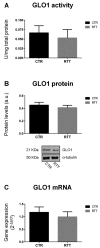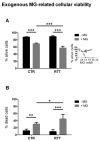Antiglycative Activity and RAGE Expression in Rett Syndrome
- PMID: 30781346
- PMCID: PMC6406506
- DOI: 10.3390/cells8020161
Antiglycative Activity and RAGE Expression in Rett Syndrome
Abstract
Rett syndrome (RTT) is a human neurodevelopmental disorder, whose pathogenesis has been linked to both oxidative stress and subclinical inflammatory status (OxInflammation). Methylglyoxal (MG), a glycolytic by-product with cytotoxic and pro-oxidant power, is the major precursor in vivo of advanced glycation end products (AGEs), which are known to exert their detrimental effect via receptor- (e.g., RAGE) or non-receptor-mediated mechanisms in several neurological diseases. On this basis, we aimed to compare fibroblasts from healthy subjects (CTR) with fibroblasts from RTT patients (N = 6 per group), by evaluating gene/protein expression patterns, and enzymatic activities of glyoxalases (GLOs), along with the levels of MG-dependent damage in both basal and MG-challenged conditions. Our results revealed that RTT is linked to an alteration of the GLOs system (specifically, increased GLO2 activity), that ensures unchanged MG-dependent damage levels. However, RTT cells underwent more pronounced cell death upon exogenous MG-treatment, as compared to CTR, and displayed lower RAGE levels than CTR, with no alterations following MG-treatment, thus suggesting that an adaptive response to dicarbonyl stress may occur. In conclusion, besides OxInflammation, RTT is associated with reshaping of the major defense systems against dicarbonyl stress, along with an altered cellular stress response towards pro-glycating insults.
Keywords: MeCP2; advanced glycation end products; dicarbonyl stress; fibroblasts; glyoxalases; methylglyoxal.
Conflict of interest statement
The authors declare no conflict of interest.
Figures






Similar articles
-
SIRT1 participates in the response to methylglyoxal-dependent glycative stress in mouse oocytes and ovary.Biochim Biophys Acta Mol Basis Dis. 2019 Jun 1;1865(6):1389-1401. doi: 10.1016/j.bbadis.2019.02.011. Epub 2019 Feb 13. Biochim Biophys Acta Mol Basis Dis. 2019. PMID: 30771486
-
Tat-glyoxalase protein inhibits against ischemic neuronal cell damage and ameliorates ischemic injury.Free Radic Biol Med. 2014 Feb;67:195-210. doi: 10.1016/j.freeradbiomed.2013.10.815. Epub 2013 Nov 16. Free Radic Biol Med. 2014. PMID: 24252591
-
Cytokine Dysregulation in MECP2- and CDKL5-Related Rett Syndrome: Relationships with Aberrant Redox Homeostasis, Inflammation, and ω-3 PUFAs.Oxid Med Cell Longev. 2015;2015:421624. doi: 10.1155/2015/421624. Epub 2015 Jul 8. Oxid Med Cell Longev. 2015. PMID: 26236424 Free PMC article.
-
Exploring the possible link between MeCP2 and oxidative stress in Rett syndrome.Free Radic Biol Med. 2015 Nov;88(Pt A):81-90. doi: 10.1016/j.freeradbiomed.2015.04.019. Epub 2015 May 8. Free Radic Biol Med. 2015. PMID: 25960047 Review.
-
Prevention of dicarbonyl-mediated advanced glycation by glyoxalases: implication in skin aging.Biochem Soc Trans. 2014 Apr;42(2):518-22. doi: 10.1042/BST20140017. Biochem Soc Trans. 2014. PMID: 24646271 Review.
Cited by
-
Altered inflammasome machinery as a key player in the perpetuation of Rett syndrome oxinflammation.Redox Biol. 2020 Jan;28:101334. doi: 10.1016/j.redox.2019.101334. Epub 2019 Oct 6. Redox Biol. 2020. PMID: 31606551 Free PMC article.
-
Reversing Glycation with a Dietary Supplement Containing Rosemary Extract.J Clin Aesthet Dermatol. 2025 Feb;18(2):44-49. J Clin Aesthet Dermatol. 2025. PMID: 40078862 Free PMC article. Review.
-
Circadian Clock and OxInflammation: Functional Crosstalk in Cutaneous Homeostasis.Oxid Med Cell Longev. 2020 Apr 23;2020:2309437. doi: 10.1155/2020/2309437. eCollection 2020. Oxid Med Cell Longev. 2020. PMID: 32377292 Free PMC article.
-
The role of RAGE in host pathology and crosstalk between RAGE and TLR4 in innate immune signal transduction pathways.FASEB J. 2020 Dec;34(12):15659-15674. doi: 10.1096/fj.202002136R. Epub 2020 Nov 1. FASEB J. 2020. PMID: 33131091 Free PMC article. Review.
-
Molecular Assessment of Methylglyoxal-Induced Toxicity and Therapeutic Approaches in Various Diseases: Exploring the Interplay with the Glyoxalase System.Life (Basel). 2024 Feb 17;14(2):263. doi: 10.3390/life14020263. Life (Basel). 2024. PMID: 38398772 Free PMC article. Review.
References
-
- Leonard H., Bower C., English D. The prevalence and incidence of Rett syndrome in Australia. Eur. Child Adolesc. Psychiatry. 1997;6:8–10. - PubMed
-
- Neul J.L., Kaufmann W.E., Glaze D.G., Christodoulou J., Clarke A.J., Bahi-Buisson N., Leonard H., Bailey M.E., Schanen N.C., Zappella M., et al. RettSearch Consortium. Rett syndrome: Revised diagnostic criteria and nomenclature. Ann. Neurol. 2010;68:944–950. doi: 10.1002/ana.22124. - DOI - PMC - PubMed
MeSH terms
Substances
LinkOut - more resources
Full Text Sources
Medical
Miscellaneous

